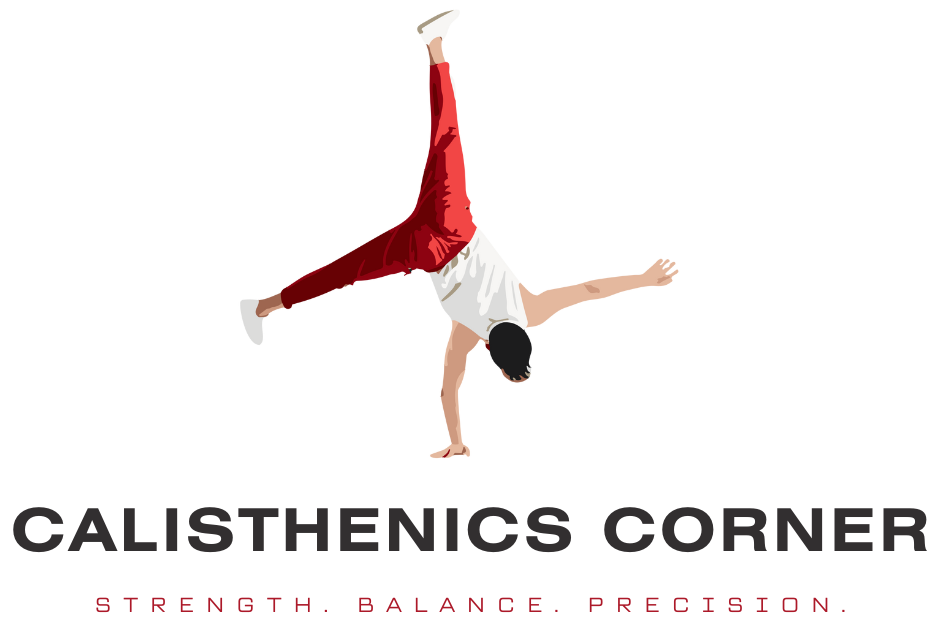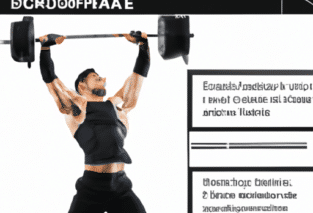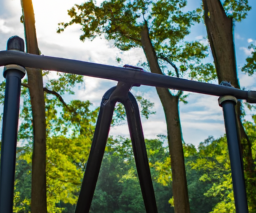If you’re looking to build strong and defined lats using calisthenics, you’ve come to the right place. In this article, we’ll explore effective strategies and exercises that can help you strengthen and develop your latissimus dorsi muscles, more commonly known as your lats. With the right approach and consistent effort, you’ll be well on your way to achieving those impressive back muscles you’ve always desired. So, let’s get started!
Importance of building lats
Function of the latissimus dorsi muscles
The latissimus dorsi muscles, commonly referred to as the lats, are the largest muscles in your back. They span from the upper arm to the lower spine and play a crucial role in a range of movements, including pulling, extending, and rotating the arms. Strong and well-developed lats are essential for performing various exercises and activities with ease and efficiency.
Benefits of strong lats
Having strong lats offers numerous benefits beyond just a muscular and aesthetic appearance. Building lats can greatly improve your overall upper body strength. Strong lats contribute to better posture, as they help stabilize your spine and pull your shoulders back, preventing slouching. Additionally, well-developed lats enhance your performance in sports that involve pulling movements, such as rock climbing, swimming, and rowing.
Why calisthenics is a great way to build lats
Calisthenics, which entails using your bodyweight as resistance, is an excellent way to build lats. It allows you to engage multiple muscles at once while providing natural and functional movements. Calisthenic exercises targeting the lats not only strengthen these muscles but also engage other supporting muscles in your back, shoulders, and arms. Moreover, calisthenics can be performed anywhere without the need for specialized equipment, making it accessible to everyone.
Fundamental calisthenic exercises for lats
Pull-ups
Pull-ups are one of the most effective exercises for building lats. To perform a pull-up, start by gripping a sturdy horizontal bar with your palms facing away from you. Hang with your arms fully extended, and then pull your body up until your chin is above the bar. Lower yourself back down to the starting position in a controlled manner. Repeat this movement for the desired number of repetitions.
Chin-ups
Chin-ups are similar to pull-ups but with a slight variation in grip. Instead of having your palms face away from you, this time, your palms should be facing towards you. With your hands shoulder-width apart, start from a fully extended hanging position and pull yourself up until your chin is above the bar. Lower yourself back down with control and repeat.
Inverted rows
Inverted rows are another highly effective exercise for targeting the lats. Find a sturdy bar about waist height and lie beneath it. Reach up and grasp the bar with an overhand grip. Your body should be straight, and your heels should be on the ground. Pull your chest up towards the bar, squeezing your shoulder blades together, and then lower your body back down. Repeat this movement for the desired number of repetitions.
Proper form and technique
Grip variations for targeting lats
To target the lats effectively during calisthenic exercises, it is important to vary your grip. Wide-grip exercises, such as wide-grip pull-ups, emphasize the outer portion of the lats. Narrow-grip exercises, like close-grip chin-ups, target the inner portion of the lats. By incorporating both grip variations into your routine, you can ensure balanced development of your lat muscles.
Maintaining shoulder and back alignment
Proper alignment of your shoulders and back is crucial for engaging the lats during calisthenic exercises. When performing pull-ups, chin-ups, or inverted rows, make sure to retract your shoulder blades and keep your back straight. Avoid excessive swinging or arching of your back, as this may shift the focus away from the lats and compromise your form. Engaging your core muscles can help maintain proper alignment and support your back.
Engaging the lat muscles throughout the movement
While performing calisthenic exercises, it is important to focus on engaging the lat muscles throughout the entire movement. Instead of solely relying on your arms to pull yourself up, consciously squeeze your shoulder blades together and engage your lats. This will ensure that you are maximizing the activation of these muscles and obtaining the full benefits of the exercise.
Progressive overload
Understanding the concept of progressive overload
Progressive overload is a fundamental principle in strength training that involves gradually increasing the demands placed on your muscles over time. To continue building lats with calisthenics, it is important to progressively challenge your muscles by increasing the workload. This can be achieved by adding reps, sets, or weight to your exercises, as well as by exploring advanced variations of calisthenic movements.
Increasing reps and sets
One way to apply progressive overload to your calisthenic routine is by gradually increasing the number of repetitions and sets you perform. Start with a manageable number of reps and sets, and as your strength improves, gradually add more. For example, if you start with 3 sets of 8 pull-ups, aim to increase it to 4 sets of 10 pull-ups over time. This gradual increase in volume will stimulate further lat growth.
Adding weight to calisthenic exercises
As you become more proficient with bodyweight exercises, you can further enhance the challenge by adding external weights. Using a weight vest, a weight belt, or holding a dumbbell between your feet during pull-ups and chin-ups can intensify the workout and create a greater stimulus for your lats. This additional resistance can lead to increased muscle activation and promote further lat development.
Accessory exercises to target lats
Lat pulldowns
Lat pulldowns are an effective accessory exercise that can complement your calisthenic routine and allow you to specifically target the lats. These can be performed using a lat pulldown machine or resistance bands. Sit down, grasp the bar with a grip wider than shoulder-width, and pull the bar down towards your chest while keeping your back straight. Control the movement as you return to the starting position and repeat.
Dumbbell rows
Dumbbell rows are an excellent exercise for directly targeting the lats, as well as the supporting muscles of the upper back. Place one knee and the same-side hand on a bench and hold a dumbbell in the opposite hand. Keeping your back straight, pull the dumbbell up towards your hip while keeping your elbow close to your body. Lower the dumbbell back down and repeat on the other side.
Bent over barbell rows
Bent over barbell rows are a compound exercise that engages multiple muscle groups, including the lats. Begin by bending at your waist with your knees slightly bent and grasp the barbell with a grip slightly wider than shoulder-width. Pull the barbell upwards towards your lower chest, squeezing your shoulder blades together. Lower the barbell back down in a controlled manner and repeat.
Incorporating bodyweight exercises into a routine
Designing a calisthenics-based workout program
To effectively build lats with calisthenics, it is essential to design a well-rounded workout program that incorporates a variety of exercises targeting the lats. Start with the fundamental calisthenic exercises mentioned earlier, such as pull-ups, chin-ups, and inverted rows. Gradually progress to more advanced variations and incorporate accessory exercises to provide additional stimulus. Remember to include rest days to allow for recovery.
Balancing pushing and pulling movements
A balanced calisthenic routine includes both pushing and pulling movements. While exercises like push-ups and dips primarily target the pushing muscles of the upper body, incorporating pulling exercises like pull-ups and chin-ups ensures that the lats and other pulling muscles are adequately stimulated. Striking a balance between these movements will promote overall upper body strength and proportionate development.
Splitting workout days for optimal lat gains
To optimize lat gains, consider splitting your calisthenics workouts into specific muscle group focus sessions. On one day, dedicate the entire session to targeting your lats and other back muscles. Perform various lat-focused exercises such as pull-ups, chin-ups, inverted rows, and accessory exercises. This targeted approach allows you to focus on maximizing the engagement and development of your lats.
Nutrition for building lats
Importance of a balanced diet
Proper nutrition plays a vital role in muscle growth and development, including the lats. For optimal results, ensure that your diet consists of a balance of macronutrients, including proteins, carbohydrates, and healthy fats. A well-rounded diet provides the necessary fuel and nutrients for muscle repair and growth, supporting your lat-building efforts.
Adequate protein intake for muscle growth
Protein is an essential nutrient for muscle growth, and ensuring an adequate intake is crucial when building lats. Aim to consume high-quality sources of protein, such as lean meats, poultry, fish, eggs, dairy, legumes, and plant-based protein sources. Spread your protein intake evenly throughout the day to support muscle repair and recovery.
Healthy fats and carbohydrates for energy
In addition to protein, your nutrition plan should include healthy fats and carbohydrates. Healthy fats, found in foods like avocados, nuts, and olive oil, provide a source of energy and support hormone production. Complex carbohydrates, such as whole grains, fruits, and vegetables, supply the body with sustained energy to fuel your workouts and aid in recovery.
Rest and recovery
The role of rest in muscle growth
Rest and recovery are crucial components of any muscle-building program, including lat development. During rest periods, your muscles have the opportunity to repair and grow stronger. Overtraining or not allowing enough rest between workouts can hinder progress and increase the risk of injury. Aim for at least one to two days of rest each week and listen to your body’s signals for adequate recovery.
Importance of allowing lats to recover
Specifically for latissimus dorsi muscle development, adequate recovery time is essential. Lats are large muscles that undergo significant stress during workouts, and they require ample time to repair and grow. Avoid training the lats too frequently, as this can impede their ability to recover and potentially lead to overuse injuries. Space out lat-focused workouts to allow for optimal recovery.
Factors affecting recovery time
Several factors can influence the recovery time needed for your lats and other muscles. These factors include the intensity and volume of your lat-focused workouts, your overall fitness level, sleep quality, nutrition, and individual differences in recovery ability. It is important to pay attention to these factors and adjust your training and recovery accordingly to optimize your lat muscle growth.

Common mistakes and how to avoid them
Using momentum instead of engaging lats
One common mistake when performing calisthenic exercises for lats is relying on momentum rather than utilizing the lat muscles. Swinging your body or using excessive momentum takes the focus away from the lats and reduces the effectiveness of the exercise. To avoid this, focus on maintaining control throughout the movement, emphasizing the contraction of the lats, and performing the exercises in a slow and controlled manner.
Neglecting proper warm-up and stretching
Neglecting a proper warm-up and stretching routine can lead to increased risk of injury and hinder lat development. Prior to your workout, include dynamic warm-up exercises, such as arm swings and shoulder circles, to increase blood flow and prepare the muscles. After your workout, perform static stretches for the back and lats to improve flexibility and aid in recovery.
Incorrect breathing during exercises
Breathing plays a significant role in maintaining proper form and maximizing lat engagement during calisthenic exercises. Inhale before initiating the exercise and exhale as you exert force during the movement. Failing to breathe properly may lead to loss of stability, reduced lat activation, and potentially compromise your performance. Focus on maintaining a controlled breathing rhythm throughout your lat-focused exercises.
Tracking progress and setting goals
Measuring lat strength and growth
Tracking your progress is essential to gauge the effectiveness of your lat-building efforts. One way to measure lat strength is by keeping a record of the number of reps and sets you can perform in exercises like pull-ups and chin-ups. Additionally, regularly take progress photos to visually assess changes in lat muscle development. Measuring strength and growth allows you to set appropriate goals and make necessary adjustments to your routine.
Setting achievable short-term and long-term goals
Setting both short-term and long-term goals is vital to maintain motivation and progress in your lat-building journey. Short-term goals could include increasing the number of pull-ups or chin-ups you can perform within a given time frame. Long-term goals may involve achieving more advanced variations of calisthenic exercises, such as muscle-ups or one-arm pull-ups. Setting achievable goals helps you stay focused and celebrate milestones along the way.
Keeping a workout journal
Keeping a workout journal can be a valuable tool for tracking your progress, recording your exercises, sets, and reps, and noting any adjustments made to your routine. It allows you to identify patterns, evaluate your performance, and make informed decisions about your training. Additionally, a workout journal serves as a motivational tool, as you can look back and see how far you have progressed in your lat-building journey.
In conclusion, building strong and well-developed lats through calisthenics offers numerous benefits, including improved upper body strength, better posture, and enhanced performance in various activities. By incorporating fundamental calisthenic exercises like pull-ups, chin-ups, and inverted rows, maintaining proper form and technique, progressively overloading your muscles, and including accessory exercises, you can effectively target and develop your latissimus dorsi muscles. Remember to also prioritize proper nutrition, rest, and recovery, avoid common mistakes, and track your progress to achieve your lat-building goals. With dedication and consistency, you can attain the impressive lat strength and development you desire.









